SAS CMH检验
Table 控制变量*分组变量*分析变量 / CMH ;

CMH用在调整某几个分层变量时非常强劲。CMH中的分析都是“计数”,通过数个数来计算的。所以会加在FREQ中。
这的stratified factor只能是分类变量。
举例:
data dat6; do id = 1 to 2; do r=1 to 4; do c=1 to 4; input freq @@; output; end; end; end; datalines; 1 4 11 27 143 411 2 9 37 66 317 1183 3 3 39 84 22 182 355 2 147 94 41 139 160 1 6 11 27 143 411 2 2 37 66 317 1183 3 5 39 84 22 182 355 2 47 94 41 139 160 ; proc freq data=dat6; tables id * r * c/nopct nocol norow chisq cmh;*Nonzero Correlation;*M-H; weight freq; run;
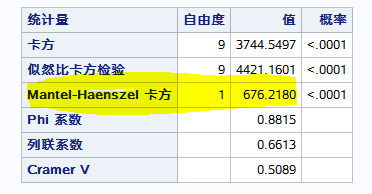
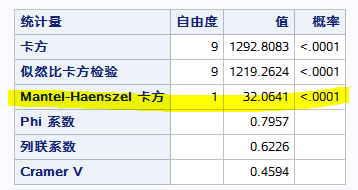
第一个图是没加CMH,没有去除中心ID效应。第二个图是加了CMH,去掉了中心ID效应,卡方值变小。
- 当加了CMH,此时只看下图CMH中那三个统计量,不需要看上述的统计量。
- 上图中的M-H卡方统计量,只有在行列都有序的情况下才看。
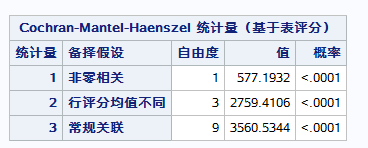
1. 行列都有顺序。

都是认为在行列都有顺序的情况下使用,一般情况下都是这么用。
*row and column are in order; data dat6; do r=1 to 4; do c=1 to 4; input freq @@; output; end; end; datalines; 4 11 143 411 9 37 317 1183 39 22 182 355 147 94 139 160 ; proc freq data=dat6; tables r * c/nopct nocol norow chisq cmh;*Nonzero Correlation;*M-H; weight freq; run;
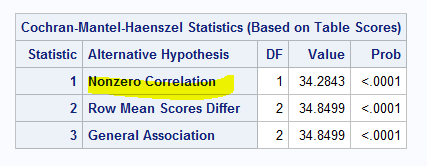
行和列都有序,也就是影响变量和反应变量都有序,看它们之间的相关性。看Non-zero Correlation, 也就是第一个。也就是非零相关。比如说服药量和红肿等级。只是说根据数类型据选取合适的统计方法。
这个就是卡方结果中的Mantel-Haenszel 卡方的,在不指定stratified factor时。
Spearman等级相关也是顺序资料,但Spearman等级相关计算时,是用等级进行的计算,而不是频数。
2. 行有序,就是影响变量有序
The two-level variable represents the response, and the other variable represents an explanatory variable with ordered levels
这是用trend选项实现Cochran-Armitage Test,限制是,反应变量是二分类变量。
*row is in order; data dat5; do r = 1 to 3; do c = 1 to 2; input freq @@; output; end; end; datalines; 59 25 169 29 196 9 ; proc freq data=dat5; tables r * c/nopct chisq nocol trend cmh; weight freq; run;
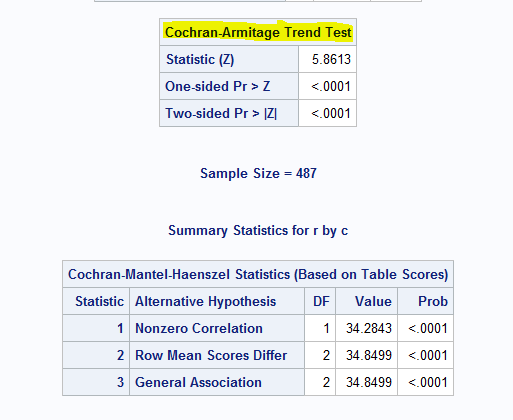
影响变量有序,说明随着影响变量的顺序,反应变量有某种趋势。加上trend。比如剂量和不良时间发生数,随着剂量增大,不良反应数减小。
3. 列有序,也就是反应变量有序。

当只有一个层时,也就是没分层因素,基本就是方差分析。
如果有多个层,相当于分层方差分析或者K-W检验。
*column is in order; data dat4; do r=1 to 2; do c=1 to 3; input freq @@; output; end; end; datalines; 13 10 6 21 7 4 ; proc freq data=dat4; tables r * c/nopct nocol chisq cmh;*row means score differ; weight freq; run;
列有序,选第二个row means score differ。说明在不同区间,反应有高有底。
如果指定 / score = rank。是Friedman检验,说明不同group间,反应是否不同。
4. 行列都无序
data dat3; do r=1 to 3; do c=1 to 4; input freq @@; output; end; end; datalines; 112 150 205 40 200 112 135 73 362 219 310 69 ; proc freq data = dat3; table r*c/chisq cmh NOROW NOCOL;*general association; weight freq; run;
行列都无序,选最后一个,general association常规关联。
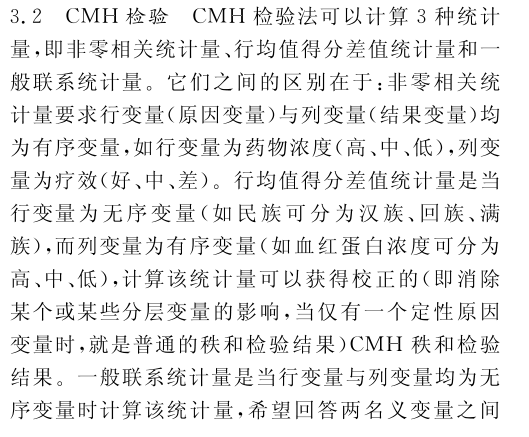

本文来自博客园,作者:Iving,转载请注明原文链接:https://www.cnblogs.com/SAS-T/p/15546015.html

